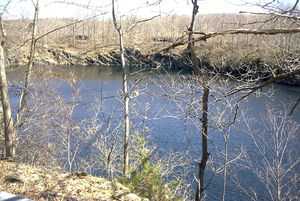Tilly Foster Mine
Coordinates: 41°24′45.98″N 73°38′31.09″W / 41.4127722°N 73.6419694°W

The Tilly Foster Mine was an iron mine in the Town of Southeast in Putnam County, New York, USA, two miles west of the village of Brewster along Route 6.
The Tilly Foster Mine was named after Tillingham Foster, who bought the land that the mine was on from George Beale. After Foster's death in 1842,[1] the property passed through several hands before it came into the possession of Harvey Iron and Steel Company. The mine opened in 1853 and employed large numbers of Irish and Italian immigrants. The jobs available at the mine played a large part in bringing immigrants to the town of Southeast. Workers were known by numbers rather than names, because the names of immigrants were considered too difficult to pronounce.
The mine reached its peak of production in the 1870s. It was 600 feet (180 meters) deep. There were 300 miners employed and they were producing 7,000 tons (14,000,000 pounds) of ore per month. The main minerals were magnetite and chondrodite.[2] The iron ore was loaded onto a train to New York City. Large quantities of Bessemer ore[3] were shipped to Scranton, Pennsylvania, and used to make steel rails for the Lackawanna Steel Company.[4]
From 1887 to 1889, the mine was made into an open pit, at the time the largest man-made pit. In 1895, there was a major collapse that killed 13 miners.[5] After the collapse it was flooded by a reservoir nearby. It was used by soldiers in World War II to test their diving equipment. A collection of minerals and artifacts from the mine is at the Southeast Museum in Brewster.
References
- ↑ Farnsworth, Cheri. (2010). Haunted Hudson Valley: Ghosts and Strange Phenomena of New York's Sleepy Hollow Country. Pennsylvania: Stackpole Books.
- ↑ Cook, R.B. 2007. "Chondrodite, Tilly Foster mine, Brewster area, Putnam County, New York". Rocks & Minerals 82 (6): 484-88
- ↑ Dana, E. S. 1874. "On serpentine pseudomorphs and other kinds from the Tilly Foster iron mine, Putnam County, New York". American Journal of Science, ser. 3, 8: 371-81
- ↑ White, James T. (1895). The National Cyclopædia of American Biography, Vol. IV, p. 216. New York: James T. White & Company.
- ↑ "Thirteen were killed", New York Times, December 1, 1895.